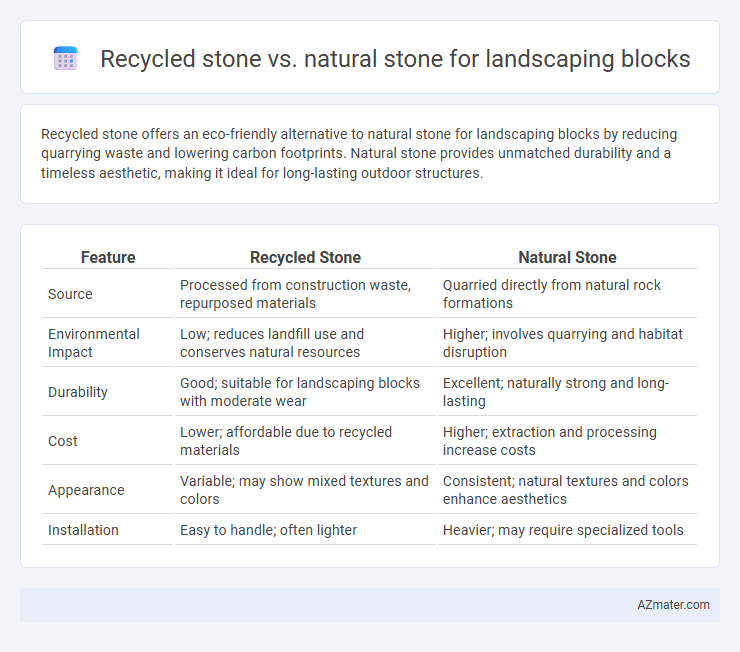Recycled stone offers an eco-friendly alternative to natural stone for landscaping blocks by reducing quarrying waste and lowering carbon footprints. Natural stone provides unmatched durability and a timeless aesthetic, making it ideal for long-lasting outdoor structures.
Table of Comparison
| Feature | Recycled Stone | Natural Stone |
|---|---|---|
| Source | Processed from construction waste, repurposed materials | Quarried directly from natural rock formations |
| Environmental Impact | Low; reduces landfill use and conserves natural resources | Higher; involves quarrying and habitat disruption |
| Durability | Good; suitable for landscaping blocks with moderate wear | Excellent; naturally strong and long-lasting |
| Cost | Lower; affordable due to recycled materials | Higher; extraction and processing increase costs |
| Appearance | Variable; may show mixed textures and colors | Consistent; natural textures and colors enhance aesthetics |
| Installation | Easy to handle; often lighter | Heavier; may require specialized tools |
Introduction to Recycled Stone and Natural Stone
Recycled stone for landscaping blocks is created from crushed and repurposed construction waste, offering an eco-friendly alternative that reduces landfill impact while maintaining durability and aesthetic appeal. Natural stone, quarried directly from the earth, provides timeless beauty with unique textures and colors, valued for its strength and long-lasting performance in outdoor applications. Both materials serve distinct environmental and design benefits, influencing choice based on sustainability goals and visual preferences.
Environmental Impact Comparison
Recycled stone landscaping blocks significantly reduce environmental impact by minimizing quarrying and conserving natural resources compared to natural stone, which involves extensive extraction processes that disrupt ecosystems. The lower carbon footprint of recycled stone results from reduced transportation energy and less waste sent to landfills, contributing to sustainable construction practices. Natural stone, while durable, demands higher energy consumption in mining and processing, increasing greenhouse gas emissions and habitat destruction.
Cost Effectiveness and Budget Considerations
Recycled stone offers a cost-effective alternative to natural stone for landscaping blocks, reducing expenses by utilizing reclaimed materials and minimizing extraction costs. Natural stone, while often more durable and aesthetically varied, typically demands higher upfront investment due to quarrying, transportation, and processing fees. Budget-conscious projects benefit from recycled stone's affordability, enabling substantial savings without compromising structural integrity or design appeal.
Durability and Longevity of Each Material
Recycled stone landscaping blocks offer impressive durability due to their engineered composition, often resisting weathering and erosion similarly to natural stone. Natural stone provides exceptional longevity, benefiting from millions of years of geological formation that contribute to its inherent strength and resistance to cracking. Both materials perform well in outdoor environments, but natural stone typically outlasts recycled stone under extreme conditions due to its dense mineral structure.
Aesthetic Appeal and Design Versatility
Recycled stone offers a unique aesthetic appeal with its varied textures and colors, derived from repurposed materials that add character and environmental value to landscaping blocks. Natural stone provides timeless beauty and rich natural variations, enhancing design versatility through its diverse range of textures such as granite, limestone, and sandstone. Both materials support creative design possibilities, but recycled stone stands out for environmentally conscious projects seeking distinctive and sustainable visual elements.
Installation Process and Ease
Recycled stone landscaping blocks offer a lightweight and more uniform size, simplifying the installation process and reducing labor time compared to natural stone. Natural stone requires more precise fitting and cutting due to irregular shapes, often necessitating specialized tools and skills for proper placement. The ease of installation with recycled stone makes it a practical choice for DIY projects and quick landscape transformations.
Maintenance Requirements Over Time
Recycled stone landscaping blocks typically demand less maintenance over time due to their enhanced durability and resistance to cracking and weathering compared to natural stone. Natural stone requires periodic sealing and careful cleaning to prevent staining, moss growth, and erosion, leading to higher long-term upkeep costs. Choosing recycled stone can reduce maintenance frequency and expenses while providing eco-friendly aesthetics for landscaping projects.
Availability and Sourcing Issues
Recycled stone for landscaping blocks is more readily available due to the increasing volume of construction and demolition waste being repurposed, reducing reliance on finite natural stone quarries. Natural stone sourcing faces challenges including environmental regulations, limited quarry locations, and longer extraction timelines, which can delay project schedules. The consistent supply of recycled stone supports sustainable landscaping practices by minimizing resource depletion and transportation impacts.
Suitability for Different Landscaping Projects
Recycled stone offers excellent sustainability benefits and is suitable for eco-friendly landscaping projects like garden paths, retaining walls, and decorative borders where cost-efficiency and environmental impact are priorities. Natural stone provides superior durability, aesthetic variety, and strength, making it ideal for high-traffic areas, architectural features, and long-term structural elements in landscaping. Selecting between recycled and natural stone depends on project requirements, including budget, desired appearance, and environmental considerations.
Making the Right Choice: Recycled vs Natural Stone
Recycled stone offers an eco-friendly, cost-effective alternative for landscaping blocks, often made from crushed concrete or masonry, reducing waste and conserving natural resources. Natural stone, such as granite or limestone, provides unmatched durability, aesthetic appeal, and long-term value but comes with higher costs and environmental impact due to quarrying. Choosing between recycled and natural stone depends on project budget, sustainability goals, and desired visual and structural qualities for the landscape design.

Infographic: Recycled stone vs Natural stone for Landscaping block
 azmater.com
azmater.com